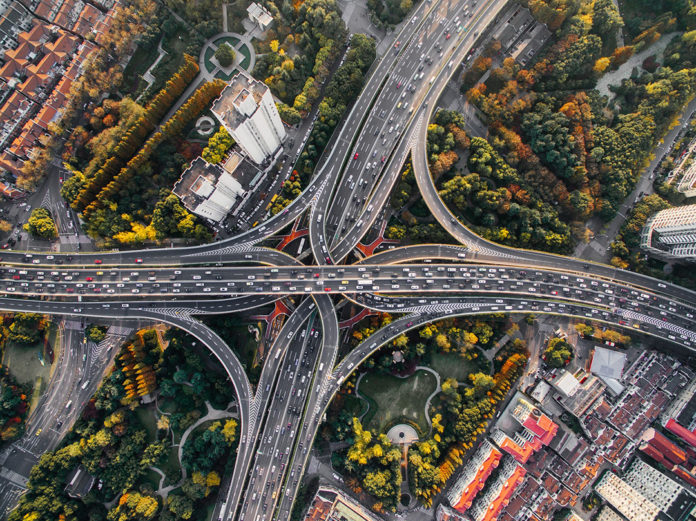Camera phones, LEDs, memory foam, and athletic shoes are just a few byproducts of space travel. Big challenges often lead to initially insurmountable problems that breed creative solutions. So let’s do something hard — let’s build a city. Let’s build it from the ground up and make it sustainable. Let’s make it a joy to live and work in. Let’s hire the brightest minds to design it. Why don’t we just decide, like deciding to go to the moon?
Now I know what you’re thinking: Brad’s lost his fucking mind. You don’t just build cities from scratch. Au contraire; it happens more often than you might think. We’re used to seeing cities grow organically, but the low up-front costs associated with it also come with the kind of problems that make urban planners wake up with night sweats.
Cities built around highways and suburbs are staggeringly inefficient. According to the UN, “cities consume 78 per cent of the world’s energy and produce more than 60 per cent of greenhouse gas emissions.” Additionally, cities are expected to grow by 2.5 billion people by 2050. This means that to combat climate change, we need to get cities right.
Consider building a kitchen: you can finance it, or you can spend a little at a time over years. With a loan, it’s a lot up-front, but you can coordinate the design and the layout, and it will be fully functional much sooner. Conversely, you can construct a kitchen piecemeal, starting with the necessities, expanding, and retrofitting over time. Anyone who’s played The Sims without a cheat code knows these trials and tribulations.
Building and designing on-the-go is more costly, disruptive, and impractical in the long term. Most urban planners must deal with the kitchen problem on a massive scale, working within the confines of existing infrastructure, private and public property, yearly budgets, the public’s daily use, and so on. It is very difficult to “un-design” existing urban spaces. It is so difficult that some countries don’t bother and just start from square one. Think of it like planning a neighborhood, but on a massive scale, where instead of planning to house 2,000 residents, you’re aiming for a million.
Finland is building a city out of timber. China and Malaysia are both building “Forest Cities;” Italy is building a tech-centric smart city in Milan; and Songdo, South Korea aims to do away with cars, and contains an interconnected network of pneumatic tubes for waste collection. Singapore has been called the “greenest city in Asia” because it constantly pushes the envelope for sustainable designs, and Copenhagen built a waste-to-energy plant with a ski slope on it — seriously.
Some of the world’s fastest-growing nations are attempting to address population booms, migration, and overcrowding by building bespoke new cities to house their next generation of residents, but purpose-built cities are not all created equally. Some are viewed as destructive boondoggles or vanity projects, like Brasilia and Naypyitaw, while others are vital, like the yet-to-be named city being built east of an overpacked Cairo. The best examples innovate and inspire. What these projects share, however, is vision, and that’s something I can at least get behind. It feels like we stopped dreaming, trading pipe-dreams for pipelines.
Canada could and should take a page out of this playbook, but it requires a completely different way of thinking. We could decide to invest in tech or manufacturing and build a bespoke city around it — similar to the way that towns spring up around oil patches, but without the unplanned laissez faire approach.
Canada should build a city of the future not because it will solve all our woes, but because it’s an ambitious and challenging undertaking. To accomplish this, we’ll need planners, designers, architects, and engineers. We’ll need to develop new technologies and problem-solve on a scale we’ve never attempted before. We’ll need to train, hire, and import skilled workers, and push students into STEM. We’ll need to ensure our new city is vibrant, healthy, and connected virtually and practically to the rest of the country.
We’d need our city to be green, sustainable, vertical, and beautiful. We’ll be forced to tackle issues of power, waste, construction, water, and movement to and through the city. We could integrate nature while keeping human spaces from damaging the environment. We could ensure a vibrant economy to protect our investment, with a diverse and robust workforce and opportunities for jobs in varied economic sectors. We could seek investment from global leaders in green technology and offer them a place to play and innovate in exchange. We’d learn and apply those lessons to existing urban areas.
Our country is fractured. We need a moonshot — something for Canadians to rally behind. Why not this? Why can’t we create a vision for ourselves — a vision of Canada at its best and most ambitious — and set out to realize it?
Long ago, when DeLoreans roamed the earth, Brad was born. In accordance with the times, he was raised in the wild every afternoon and weekend until dusk, never becoming so feral that he neglected to rewind his VHS rentals. His historical focus has assured him that civilization peaked with The Simpsons in the mid 90s. When not disappointing his parents, Brad spends his time with his dogs, regretting he didn’t learn typing in high school.



